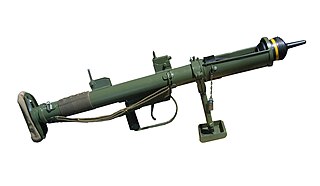
The Projector, Infantry, Anti Tank (PIAT) Mk I was a British man-portable anti-tank weapon developed during the Second World War. The PIAT was designed in 1942 in response to the British Army's need for a more effective infantry anti-tank weapon and entered service in 1943.

A mortar is usually a simple, lightweight, man-portable, muzzle-loaded weapon, consisting of a smooth-bore metal tube fixed to a base plate with a lightweight bipod mount and a sight. They launch explosive shells in high-arcing ballistic trajectories. Mortars are typically used as indirect fire weapons for close fire support with a variety of ammunition.

A multiple rocket launcher (MRL) or multiple launch rocket system (MLRS) is a type of rocket artillery system that contains multiple launchers which are fixed to a single platform, and shoots its rocket ordnance in a fashion similar to a volley gun. Rockets are self-propelled in flight and have different capabilities than conventional artillery shells, such as longer effective range, lower recoil, typically considerably higher payload than a similarly sized gun artillery platform, or even carrying multiple warheads.

The WAC Corporal was the first sounding rocket developed in the United States and the first vehicle to achieve hypersonic speeds. It was an offshoot of the Corporal program, that was started by a partnership between the United States Army Ordnance Corps and the California Institute of Technology in June 1944 with the ultimate goal of developing a military ballistic missile.

The Type 97 sniper rifle is a Japanese bolt-action rifle, based on the Type 38 rifle. Following the standard practice of the time, it was adapted from an existing infantry rifle. The only difference between this rifle and the original Type 38 is that it had a lightened stock, a 2.5 power telescopic sight and a mid-band setup for a monopod, although later models had this deleted. The rifle entered service in 1937. When fired, the mild 6.5x50mm Arisaka cartridge gave off little flash or smoke and made counter-sniper activity difficult. The lack of flash and smoke comes from the length of the barrel; a 797 millimetres (31.4 in) long barrel allows cartridge propellant to fully burn and attain the optimum combination of accuracy and bullet velocity. The scope was offset to the left, to allow stripper clip loading. Like other Mauser pattern rifles, it has a five-round box magazine. The rifle can be loaded with either a 5-round stripper clip, or single rounds.

The Type 11 70 mm infantry mortar, was a muzzle-loading, rifled bore infantry mortar used by the Japanese. The Type 11 designation was given to this gun as it was accepted in the 11th year of Emperor Taishō's reign (1922). It was first used in 1922 and was the first mortar to be introduced by the Imperial Japanese Army. The mortar was later replaced by the Type 92 battalion gun.
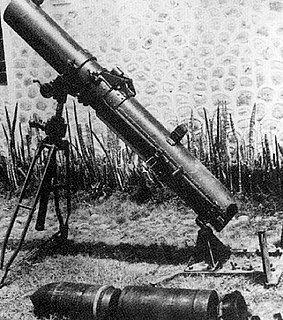
The Type 4 20 cm rocket mortar was a 203 mm rocket mortar used by the Imperial Japanese Army in the final stages of World War II.
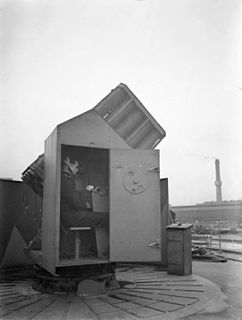
The Unrotated Projectile (UP) was a British anti-aircraft and ground-bombardment rocket of the Second World War. A 7-inch version was developed for the Royal Navy by Alwyn Crow of the Projectile Development Establishment of the Ministry of Supply at Fort Halstead. It proved unreliable and ineffective and was withdrawn from use in 1941. Development of the concept led to the UP-2 and UP-3, which had diameters of 2-inch and 3-inch respectively but were longer. The latter was used as the basis of the Z Battery anti-aircraft weapons and later developed in air-to-ground form as the RP-3, used against ground forces and shipping by aircraft like the Hawker Typhoon and the Bristol Beaufighter. In 1944–1945 several adaptations for general bombardment were produced, including Sea Mattress, Land Mattress, LILO and Tulip.

The English Electric Thunderbird was a British surface-to-air missile produced for the British Army. Thunderbird was primarily intended to attack higher altitude targets at ranges up to approximately 30 miles (48 km), providing wide-area air defence for the Army in the field. AA guns were still used for lower altitude threats. Thunderbird entered service in 1959 and underwent a major mid-life upgrade to Thunderbird 2 in 1966, before being slowly phased out by 1977. Ex-Army Thunderbirds were also operated by the Royal Saudi Air Force after 1967.

Rocket artillery is artillery that uses rocket explosives as the projectile. The use of rocket artillery dates back to medieval China where devices such as fire arrows were used. Fire arrows were also used in multiple launch systems and transported via carts. First true rocket artillery was developed in India by the Kingdom of Mysore. In the late nineteenth century, due to improvements in the power and range of conventional artillery, the use of early military rockets declined; they were finally used on a small scale by both sides during the American Civil War. Modern rocket artillery was first employed during World War II, in the form of the German Nebelwerfer family of rocket ordnance designs, Soviet Katyusha-series and numerous other systems employed on a smaller scale by the Western allies and Japan. In modern use, the rockets are often guided by an internal guiding system or GPS in order to maintain accuracy.

Explorer 5 was a United States satellite with a mass of 17.43 kg (38.4 lb). It was the last of the original series of Explorer satellites built, designed, and operated by the Jet Propulsion Laboratory.

The Stokes mortar was a British trench mortar designed by Sir Wilfred Stokes KBE that was issued to the British and U.S. armies, as well as the Portuguese Expeditionary Corps, during the latter half of the First World War. The 3-inch trench mortar is a smooth-bore, muzzle-loading weapon for high angles of fire. Although it is called a 3-inch mortar, its bore is actually 3.2 inches or 81 mm.
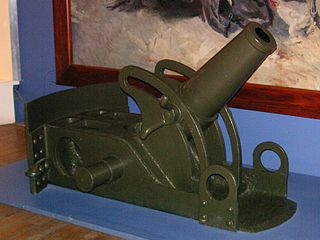
The Mortier de 58 mm type 2 or Mortier de 58 mm T N°2, also known as the Crapouillot or "little toad" from its appearance, was the standard French medium trench mortar of World War I.
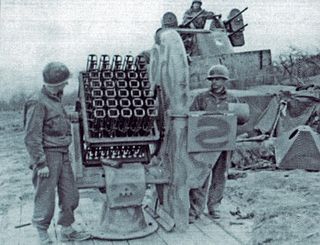
The Henschel Hs 297 Föhn or 7.3 cm Raketen Sprenggranate was a small German surface-to-air rocket of the Second World War. The associated multiple rocket launcher was known as the 7.3 cm Föhn-Gerät.
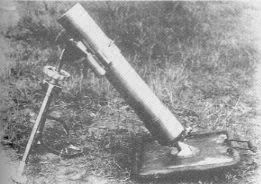
The Type 99 81 mm mortar was a Japanese mortar used primary by Imperial Japanese Army during World War II. The Type 99 designation was given to this mortar as it was accepted in the year 2599 of the Japanese calendar (1939). The Type 99 81 mm mortar is typical of the Stokes-Brandt type mortar. The Type 99 81 mm mortar differs from the Type 97 81 mm infantry mortar in the shortness of its tube and in the method of firing. The differences between the Type 99 and the US 81-mm mortar, M1 are pronounced.

The Sprengpatrone or "explosive cartridge" in English was a rifle grenade that was developed by Germany and used by the Wehrmacht during World War II. The Sprengpatrone was designed to be fired from a Kampfpistole flare gun.

The 20 cm naval rocket launcher was a rocket artillery system used by the Imperial Japanese Navy in the final stages of World War II.
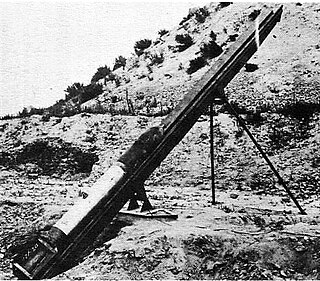
The Type 21 and Type 22 rocket-bombs were rocket artillery systems used by garrison troops of the Imperial Japanese Navy during the late stages of World War II in defense of island bases in the Pacific.

The 45 cm naval rocket was a rocket artillery system used by garrison troops of the Imperial Japanese Navy during the late stages of World War II in defense of island bases in the Pacific.
























